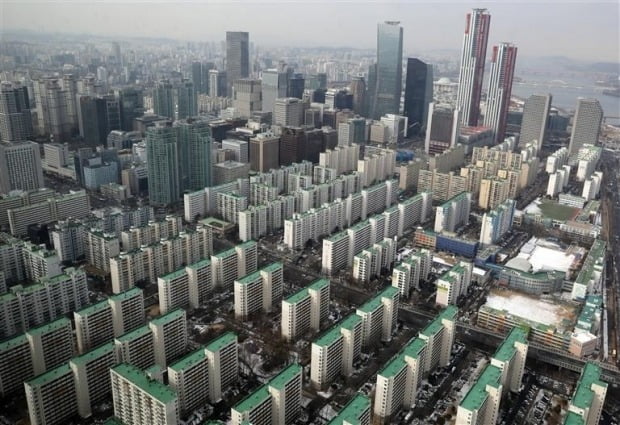
View of apartment complexes in Yeouido, Seoul. / Source = News 1
Who is the main culprit behind the rise in home prices? You want to say that the government is a speculator. It is because the speculators raised the house price, and the government only continued to announce policies to prevent the increase in house prices.
Since the participatory government, the most severely stamped complex by the government is Eunma Apartment in Daechi-dong. A daily newspaper analyzed the registered copies of 1147 Eunma apartments and reported that 577 households (50.3%) of landlords had no loans at all. Overall, 58.3% were those who owned Eunma apartments for more than 10 years. Where are all speculators?
The debate between investment and speculation is mostly a political sorcerer with a specific purpose. In order to face reality, we rather have to doubt the people and groups that induce or arouse these arguments. In 2017, when the current government came to power, the 8.2 real estate measures were announced, which was as strong as ever. But was such a strong measure necessary in the real estate market at the time? Over the past 30 years, the average sale price of apartments in Gangnam has increased by 5%. Until July 2017, the sale price of Gangnam apartments was recording a 3% increase.
At the time of 2017, the average of the last 30 years was very normal in Gangnam. How did all-time real estate measures affect the normal apartment market? As you may already know, from then on, apartments in Seoul began to rise in earnest. As of today, apartment prices are rising along the way, and it’s hard to find any reason for falling.
This controversy doesn’t even have to be found in the distant past. In the first half of 2020, the apartment market in Seoul was stable. According to KB Kookmin Bank, the rate of increase in trading prices was only 2.61%. In particular, Gangnam-gu was 1.01% and Seocho-gu was 0.80%, which was much lower than the Seoul average. However, the market began to move after August, when the 2nd Lease Act came into effect following the June 17 and July 10 real estate countermeasures. In the second half of last year, apartment sales prices in Seoul rose 10.19%. What’s even more surprising is Gangnam-gu, which has been quiet. The increase rate of the trading price in Gangnam-gu will rise vertically to 8.3%.
Why did this happen? That’s because tradeable apartments disappear due to regulations. The current government is still eagerly reducing the number of available apartments. The demand for housing has also decreased, but the supply has declined even further, leading to higher prices. Apartment prices are just a byproduct of the boring psychological game of supply and demand. I have no choice but to suspect that apartment prices are being raised by the government, neither speculators nor homeowners.
Recently, populist policies, which are suspected of being conscious of elections, have been the main culprit for rising house prices. A representative example is the Metropolitan Express Train (GTX). Local government heads in the metropolitan area are fighting to attract the GTX-D route, which is not yet included in the railroad plan, but when the news that GTX Changneung Station will be built, the sale price of 30 pyeong apartments in Samsong and Wonheung exceeded 1 billion won. . The asking price is said to reach 1.2 billion won. All of these price increases are the result of the Ministry of Land, Infrastructure and Transport officially establishing a new Changneung Station on the GTX-A line.
Public redevelopment, public redevelopment, etc. The current government likes’public’. The slogan of the supply measures announced on February 4 is’If the public is led, sufficient housing can be supplied quickly.’ There seems to be no awareness of the shortage of apartments in Seoul as the maintenance project in Seoul was stopped due to public intervention. The previous countermeasures, including Taereung Golf Course, came out where all the countermeasures went. It is difficult to memorize experts in the real estate industry such as urban public housing complex project, public direct implementation maintenance project, and residential regeneration innovation district. Because of this, surrounding land prices are likely to be upbeat. In the case of a house that was purchased after the announcement of the measures, it would even be stern that it would not give priority to supply.
The same goes for the increase in the published price. It was a means to catch the house price and impose a lot of tax, but as the published price increases, the house price increases sequentially. The method of determining the price of the pre-sale price limit system is the cost method, because if the land price increases due to the increase in the published price, the upper limit pre-sale price will also increase. In the case of a reconstruction apartment in Banpo-dong, the upper limit of the pre-sale price is higher than the amount requested by the association, and the pre-sale price limit system is said to be useless.
It should be understood that all current government actions are a kind of development project. The development project must raise the price of the surrounding land or apartments. If Seoul had not regulated the redevelopment and reconstruction projects, it would have been possible to see a stable apartment market even if there was some overheating (price increase). However, despite the short cut, the government is steadily raising apartment prices through various detours. If the shortage of occupancy in Seoul and the increase in apartment prices caused by the government are combined, it would be an expectation that apartment prices will fall again this year.
<한경닷컴 The Moneyist> Hyung-Seok Shim Director, Woodae Bread Research Institute
<독자 문의 : [email protected]>
